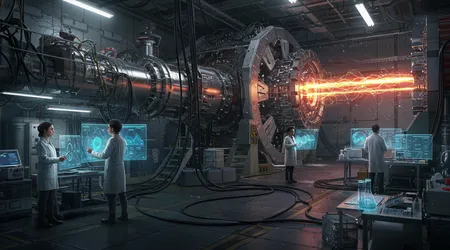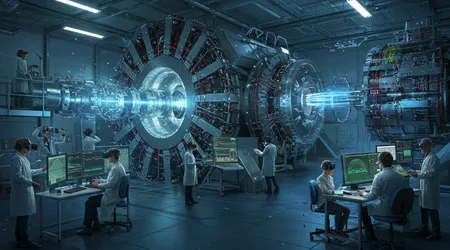The Hunt for the Fifth Force of Nature

The Fifth Force of Nature could rewrite physics, challenging our understanding of the cosmos. For decades, scientists have recognized four fundamental forces: gravity, electromagnetism, the strong nuclear force, and the weak nuclear force.
Anúncios
These pillars govern everything from planetary orbits to atomic interactions. Yet, whispers of a mysterious fifth force have sparked curiosity and debate, pushing researchers to probe the universe’s deepest secrets.
Could an undiscovered force be the key to unifying physics or explaining cosmic enigmas like dark matter?
This article dives into the cutting-edge quest for this elusive force, blending recent discoveries with the promise of revolutionary insights. Join us as we explore the science, skepticism, and stakes of this cosmic hunt.
The search for a Fifth Force of Nature isn’t just academic it’s a journey to redefine reality. Recent studies, like those tracking asteroid trajectories, hint at anomalies that could point to new physics.
Anúncios
This pursuit bridges particle physics and cosmology, demanding precision and imagination.
From lab experiments to space observations, scientists are chasing clues that could reshape textbooks. Let’s unpack the why, how, and what’s next in this thrilling scientific odyssey.
Why the Fifth Force of Nature Matters
The idea of a Fifth Force of Nature challenges the Standard Model, physics’ blueprint for particle interactions. This model, while robust, leaves gaps dark matter and dark energy remain unexplained.
A new force could bridge these mysteries, offering insights into the universe’s unseen 27% of mass-energy attributed to dark matter. Scientists speculate it might mediate interactions beyond current understanding, reshaping cosmology.
Consider the stakes: a new force could unify gravity with quantum mechanics, a decades-long puzzle. The Standard Model excels at subatomic scales but falters with gravity’s cosmic reach.
++ How Magnetic Fields Might Influence Human Behavior
A Fifth Force of Nature might reconcile these realms, unlocking applications from energy to space exploration. The quest drives innovation, pushing technology to detect faint signals in atomic structures.
This pursuit isn’t abstract it’s a detective story. Like searching for a hidden planet by its gravitational tug, physicists hunt subtle anomalies in particle behavior.
The potential reward? A paradigm shift rivaling Einstein’s relativity. Yet, skepticism persists, as unconfirmed claims demand rigorous evidence. The hunt continues, fueled by curiosity and precision.

Breakthroughs and Clues in the Search
Recent experiments offer tantalizing hints of a Fifth Force of Nature. In 2023, Fermilab’s Muon g-2 experiment reported anomalies in muon behavior, suggesting unknown interactions.
These deviations, though small, challenge predictions, hinting at new physics. Meanwhile, asteroid Bennu’s trajectory, studied via NASA’s OSIRIS-REx, showed no conclusive fifth-force evidence but refined search methods.
Precision is key. Advanced particle accelerators, like CERN’s Large Hadron Collider, probe subatomic realms for unexpected particles. A 2015 Hungarian study detected a potential “dark photon,” a candidate for mediating a new force.
Also read: Quantum Biology: How Birds May Use Quantum Mechanics to Navigate
Though unconfirmed, it spurred global research. These experiments demand cutting-edge tools, from laser spectroscopy to space-based sensors, to catch fleeting signals.
The data paints a complex picture. Below is a table summarizing key experiments in the Fifth Force of Nature search, highlighting their focus and outcomes:
| Experiment | Year | Focus | Outcome |
|---|---|---|---|
| Hungarian Dark Photon | 2015 | Radioactive decay anomalies | Potential new particle detected |
| Fermilab Muon g-2 | 2023 | Muon magnetic moment | Anomalies suggest unknown interactions |
| OSIRIS-REx (Bennu) | 2023 | Asteroid trajectory analysis | No conclusive evidence, refined methods |
These efforts show science’s relentless push to test boundaries. Each null result narrows the search, while anomalies ignite hope.
The next breakthrough may lie in upcoming missions, like Apophis’ 2029 flyby, offering fresh data.
Progress isn’t linear. False positives, like the 2016 diphoton excess at CERN, sparked excitement before fading. Yet, each step hones techniques, from quantum sensors to AI-driven data analysis.
Read more: Slime Mold Intelligence: How a Brainless Organism Solves Mazes
The hunt thrives on persistence, with researchers worldwide collaborating to decode the universe’s signals. What new tools will uncover the next clue?
Challenges in Proving a New Force
Confirming a Fifth Force of Nature is no small feat. The Standard Model’s predictions are precise, making deviations hard to detect.
Experiments require unprecedented sensitivity to measure tiny effects, like shifts in particle spin. Background noise, from cosmic rays to thermal fluctuations, complicates data interpretation, demanding sophisticated filters.
Skepticism is a hurdle. Many physicists argue anomalies could stem from errors or known forces. The 2015 Hungarian study, for instance, faced scrutiny for lacking replication.
Extraordinary claims need extraordinary evidence, and peer review is ruthless. Researchers must balance bold hypotheses with rigorous validation to avoid false hopes.
Resources pose another challenge. High-energy experiments, like those at CERN, cost billions and years to design.
Smaller labs struggle to compete, limiting global efforts. Yet, ingenuity shines crowdsourced data from citizen scientists and AI now aid analysis, democratizing the hunt. Will these collaborative efforts tip the scales?
The theoretical landscape is murky. A new force could manifest in countless ways, from short-range atomic effects to cosmic-scale influences.
Defining its properties strength, range, or particle mediator requires diverse experiments. The lack of a unified theory complicates predictions, but it also fuels creativity in experimental design.
Real-World Implications and Analogies
Imagine a Fifth Force of Nature as a hidden current in a river, subtly steering boats off course. Scientists are like navigators, mapping this current through precise measurements.
If confirmed, this force could transform technology, much like electromagnetism birthed radio and computers. Applications might include advanced propulsion or energy systems.
Take a practical example: quantum sensors detecting a new force could revolutionize navigation, bypassing GPS vulnerabilities.
In medicine, understanding new particle interactions might enhance imaging techniques, spotting diseases with unmatched precision. These possibilities, though speculative, highlight the stakes of uncovering new physics.
Another example lies in cosmology. A fifth force could explain why galaxies cluster oddly, defying gravity’s pull.
In 2023, a study in Nature Communications Physics noted Bennu’s trajectory showed no fifth-force signs, yet refined models for future tests. This statistic 27% of the universe’s mass-energy as dark matter underscores the gap a new force might fill.
The implications extend philosophically. Discovering a new force would redefine humanity’s place in the cosmos, much like Copernicus’ heliocentric model.
It could answer why the universe expands at its current rate. Such a shift invites awe: what else lies beyond our current grasp?
The Future of the Hunt

The road ahead for the Fifth Force of Nature is thrilling yet uncertain. The 2029 Apophis flyby offers a prime chance to test asteroid trajectories for anomalies.
NASA’s planned missions, paired with AI-driven analysis, could spot subtle deviations, building on Bennu’s lessons. Precision will define success.
Particle physics isn’t slowing down. Upgrades to CERN’s collider and new facilities, like China’s CEPC, aim to probe deeper.
These projects, set for the late 2020s, could detect particles mediating a new force. Global collaboration, sharing data openly, accelerates progress, uniting experts across borders.
Public engagement is growing. Citizen science platforms, like Zooniverse, let enthusiasts analyze telescope data, aiding the search.
This democratization mirrors the internet’s rise, making science accessible. Imagine amateurs spotting a key anomaly could a hobbyist unlock the next breakthrough?
Theoretical models are evolving. Some propose a Fifth Force of Nature tied to extra dimensions, testable via gravitational wave detectors like LIGO.
Others explore connections to dark energy. These ideas, while speculative, guide experiments, ensuring no stone is unturned.
Conclusion: A Cosmic Quest Unfolds
The hunt for the Fifth Force of Nature is more than a scientific endeavor it’s a testament to human curiosity.
Each experiment, from Fermilab to asteroid missions, peels back the universe’s layers. While no definitive proof exists yet, the journey reshapes our tools, theories, and dreams. Will we find this force, or will it remain a cosmic tease?
This quest transcends labs, inviting us to ponder our place in the vast unknown. A new force could unlock technologies, redefine physics, or reveal the universe’s hidden architecture.
As we stand on the brink of 2029’s Apophis flyby, the anticipation grows. The universe is whispering can we hear its secrets?
Frequently Asked Questions
**What is the **Fifth Force of Nature?
It’s a hypothetical force beyond gravity, electromagnetism, and nuclear forces, potentially explaining cosmic mysteries like dark matter.
How do scientists search for it?
They use particle accelerators, asteroid tracking, and quantum sensors to detect anomalies in particle behavior or cosmic trajectories.
Why hasn’t it been confirmed?
Detecting tiny deviations is challenging, and anomalies often stem from errors or known forces, requiring rigorous validation.
What could a fifth force change?
It might unify physics, enhance technologies like navigation or imaging, and explain cosmic phenomena like galaxy clustering.
How can the public help?
Citizen science platforms let enthusiasts analyze data, contributing to discoveries alongside professional researchers.
